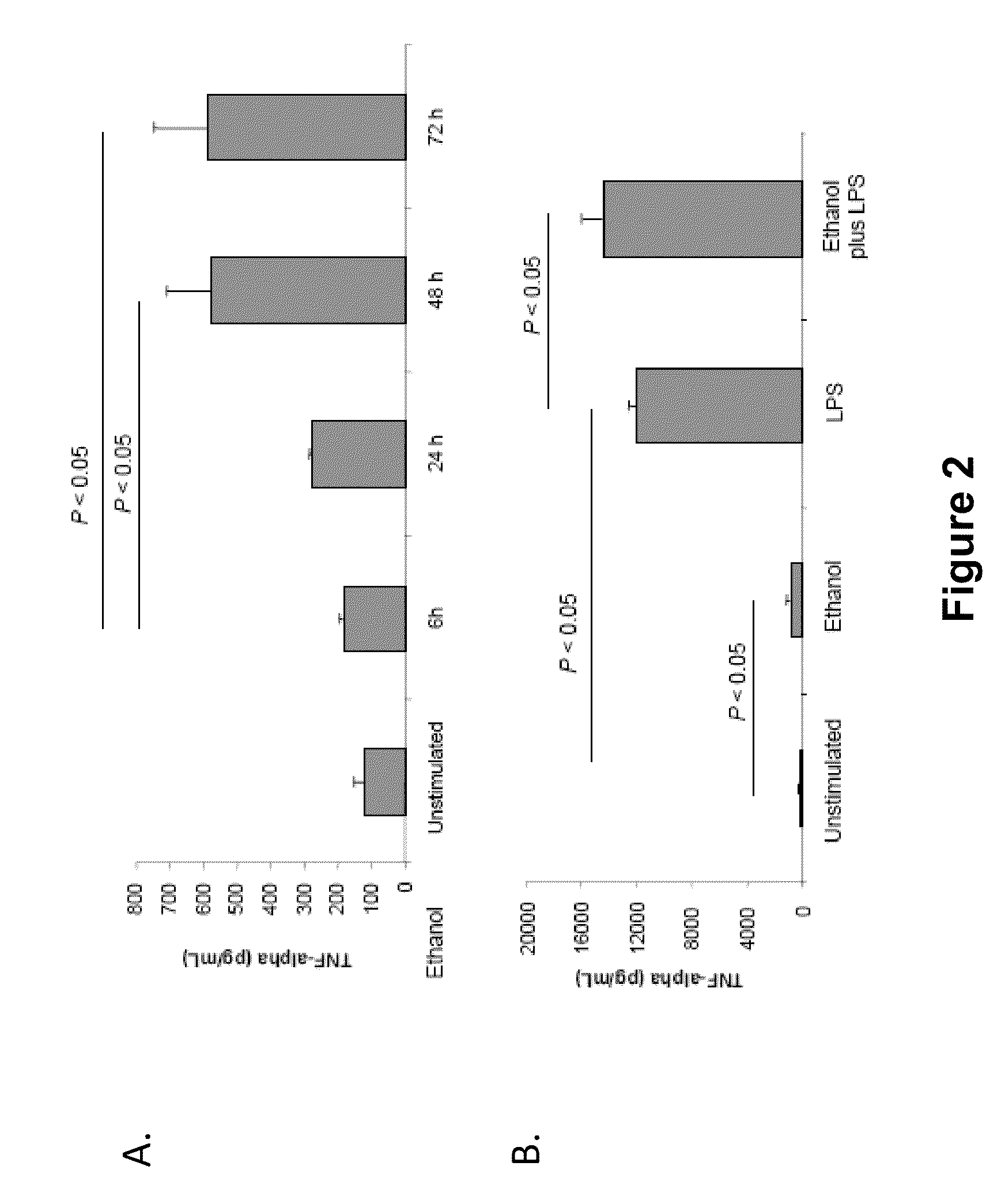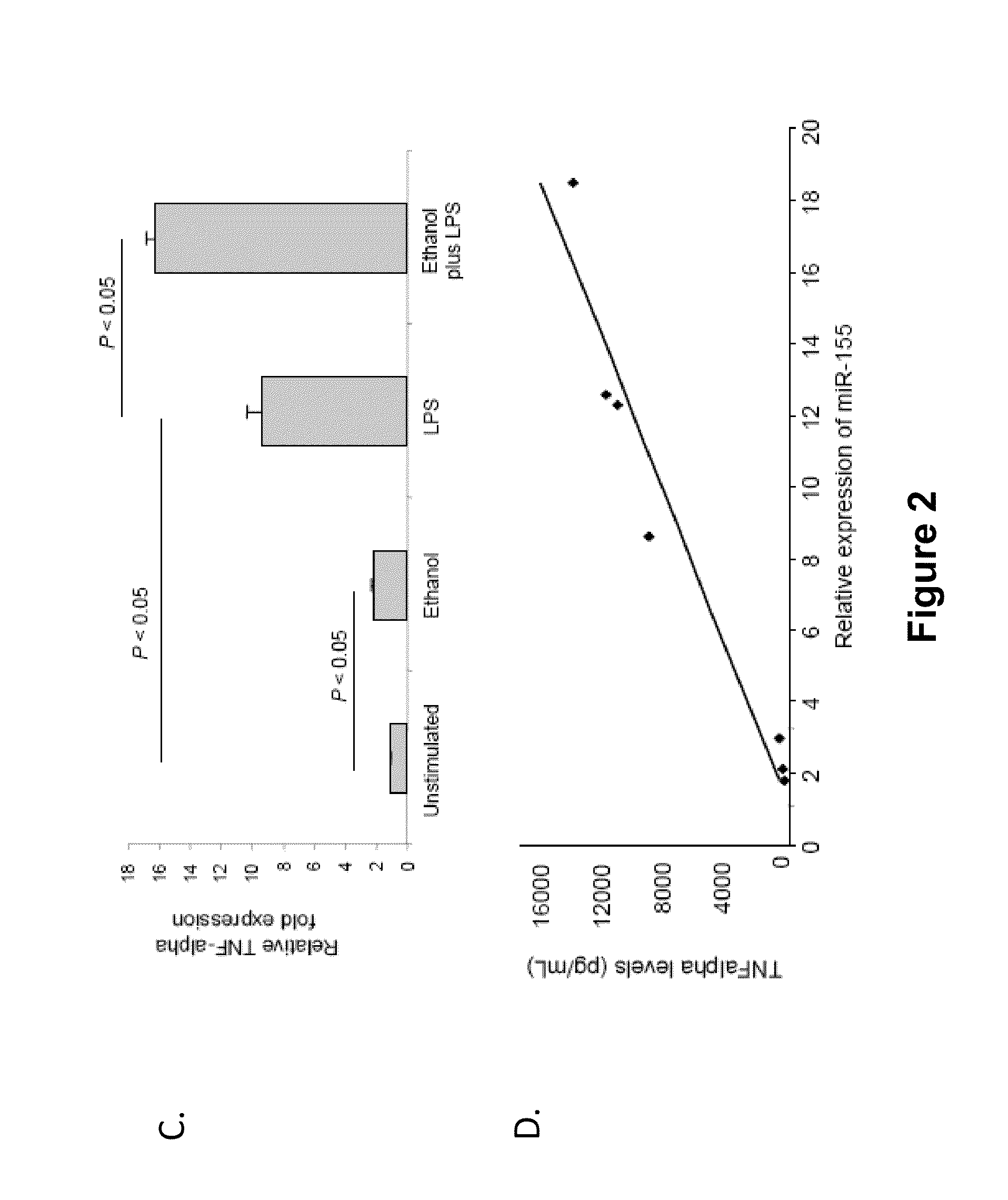Antagonists of mir-155 for the treatment of inflammatory liver disease
- Summary
- Abstract
- Description
- Claims
- Application Information
AI Technical Summary
Benefits of technology
Problems solved by technology
Method used
Image
Examples
example 1
MiR155 Expression is Up-Regulated in Macrophages after Ethanol and / or LPS Stimulation In Vitro and Correlates with TNF-α Production
[0127]TNF-α, an LPS-induced cytokine, is increased in ALD (Mandrekar & Szabo, J. Hepatol., 2009, 50: 1258-1266). In particular, prolonged ethanol exposure leads to an increase in inflammatory cell responses, particularly in LPS-induced TNF-α production in macrophages and Kupffer cells (KCs). To test whether alcohol affects TNF-α production via regulation of miRNAs, RAW 264.7 cells, a surrogate model of KCs with respect to alcohol-induced TNF-α production (Szabo & Mandrakar, Alcohol Clin. Exp. Res., 2009, 33: 220-232), were studied. It was determined that a physiologically relevant dose of ethanol (50 mM) resulted in significant up-regulation of miR155 within 6-72 hours, with the highest induction in the presence of prolonged alcohol exposure (72 hours) (FIG. 1A). Notably, the alcohol-induced increase was specific to miR-155 as there were no significant c...
example 2
MiR155 is Up-Regulated In Vivo in Kupffer Cells of Alcohol-Fed Mice
[0129]Chronic alcohol feeding of mice with a Lieber-DeCarli diet results in a significant increase in serum ALT, serum ethanol and endotoxin levels in mice as early as 1 week after alcohol feeding. These abnormalities are sustained throughout the 4 weeks of alcohol feeding (FIG. 3A, B and C). Further experiments also included measurements at weeks 2 and 3 (see Bala et al. J. Biol. Chem. 2011. 286:1436-1444) incorporated herein by this reference. Evaluation of liver histology reveals the presence of steatosis and inflammatory cells in ethanol-fed (but not pair-fed) mice (FIG. 3D).
[0130]To assess the in vivo effects of alcohol on miR155 and TNF-α production, Kupffer cells were isolated from livers of alcohol-fed and control mice. KCs isolated from ethanol-fed mice showed increased TNF-α production and TNF-α mRNA expression compared to pair-fed mice (FIG. 4 A, B). Further experiments were done and the statistics obtaine...
example 3
MiR155 Expression is Unregulated in Total Livers and Hepatocytes after Exposure to Alcohol
[0131]The role of miR-155 was also elucidated in different cell types of the liver. After mice were treated for 4 weeks with the Lieber-DeCarli diet (liquid alcohol diet), increased expression of miR-155 was observed in total livers and in isolated hepatocytes from the alcohol-fed mice (FIG. 6). Together with the observation that prolonged alcohol exposure increases miR-155 in macrophages and Kupffer cells, this observation provides that miR-155 is also increased in hepatocytes in alcoholic liver disease. Thus, these data demonstrate that miR-155 is involved in cell-specific functions.
PUM
| Property | Measurement | Unit |
|---|---|---|
| Fraction | aaaaa | aaaaa |
| Stability | aaaaa | aaaaa |
Abstract
Description
Claims
Application Information
 Login to View More
Login to View More - R&D
- Intellectual Property
- Life Sciences
- Materials
- Tech Scout
- Unparalleled Data Quality
- Higher Quality Content
- 60% Fewer Hallucinations
Browse by: Latest US Patents, China's latest patents, Technical Efficacy Thesaurus, Application Domain, Technology Topic, Popular Technical Reports.
© 2025 PatSnap. All rights reserved.Legal|Privacy policy|Modern Slavery Act Transparency Statement|Sitemap|About US| Contact US: help@patsnap.com



